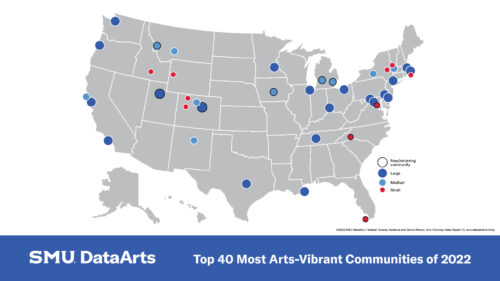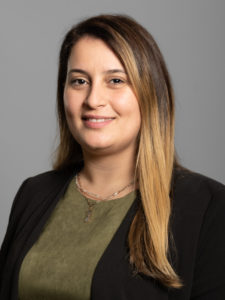The Most Vibrant Arts and Culture Communities
Hywel Sims, Senior Vice President
Menon Dwarka, Senior Vice President
Nagham Wehbe, Vice President – Research Practice Leader
The 2022 Arts Vibrancy Index Report by SMU DataArts has been released recently, highlighting the most arts-vibrant communities across the United States using data-informed indices. The report analyzes four measures under each of three main rubrics: supply, demand, and public support for arts and culture on a per capita basis. However, in recognition of the COVID-19 pandemic's impact on the arts and culture sector, the report refrains from providing an overall ranking.
The federal and local government play different roles in shaping cultural policy and community vibrancy in Canada. The Canada Council for the Arts, as well as many provinces and municipalities, are at the forefront of equitably investing in communities from coast to coast to coast. Strategic and economic development plans, and tracking of implementation results, are keys to advancing the creative industries.
The pandemic has significantly impacted the revenue of arts organizations, leading to closures and changes in programming in both the United States and Canada. This has brought to light the inequities in the retention of workforces within these organizations, with unemployment rates in the arts industry being twice that of overall national unemployment, and disproportionately affecting marginalized groups. This edition of Arts Insights looks at perspectives and considerations in each country.
Key Findings in the USA
The Impact of COVID-19 on Arts Organizations and Communities - The COVID-19 pandemic has had a significant impact on the financial stability of arts organizations, leading to closures and changes in programming. However, communities with high levels of vibrancy have adapted by investing in virtual and live-streamed offerings, expanding outdoor programming, and supporting their local constituents through donations and information sharing. Additionally, social equity issues have come to the forefront, with art being utilized to amplify conversations around equity. Follow-up surveys have generated ideas for generating investment from virtual and live-streaming, outdoor programming, and mobilizing support from local constituents.
Thriving Arts Communities in Every Region of the United States - The United States has thriving arts communities in every region of the country, according to objective data analysis. These communities celebrate and value the unique artistic expressions and successes of their respective regions, spanning from Utah to Florida and New York to Iowa.
High Concentration or Dispersion of Vibrant Arts and Culture in Metropolitan Statistical Areas - In metropolitan statistical areas (MSAs), the vibrancy of arts and culture is achieved through either a concentrated presence in the urban core or widespread dispersion throughout the larger metropolitan region. To accurately assess the effectiveness of these approaches, it is important to consider the impact of distance on attendance rates, which can inform decisions regarding concentration versus dispersion strategies.
Evolving Arts and Culture Trends in the USA
When assessing the level of arts and culture within a community, it is important to consider recent developments such as the establishment or closure of performance spaces or dedicated arts districts. Additionally, population growth can have a significant impact on the supply and demand of artistic offerings, and financial metrics must be adjusted accordingly, considering the cost-of-living and other relevant factors. Arts Vibrancy Index (AVI) calculations are continuously refined with new data, and it considers a range of factors, including proximity to arts organizations, concentration of artistic activity, and community engagement, when making necessary adjustments.
The Methodology
SMU DataArts recognizes the interdependence between arts and cultural organizations and their communities. By combining data from nonprofit organizations with community characteristics, they identify factors that affect the sustainability of the arts. The Arts Vibrancy Index (AVI) helps arts leaders, businesses, government agencies, funders, and citizens understand the intensity and capacity of a community's arts and culture sector. The AVI reports and interactive map aid arts leaders in relocating their operations and benchmarking communities against an aspirational set. The AVI's multidimensional framework provides insights into why two seemingly different cities might be close in ranking. The AVI ranking focuses solely on arts and culture with a heavy emphasis on the nonprofit sector, drawing measures from existing literature and SMU DataArts' Model of the Arts & Culture Ecosystem.
The Top 40 Arts-Vibrant Communities of 2022
The AVI report refrained from ranking communities based on their overall arts vibrancy, owing to the significant impact of COVID-19 on the arts sector. Instead, the report brings to the fore the top 40 communities of varying sizes that exhibit commendable arts vibrancy. The report underscores the need for introspection and support towards communities to help them sustain their resilience in these challenging times.

The lists below are sorted alphabetically and by Metropolitan Statistical Area (MSA) but not by overall arts vibrancy rankings.
Large Communities (MSA over 1 million)
-
- Austin-Round Rock-Georgetown, TX
- Boston, MA
- Cambridge-Newton-Framingham, MA
- Chicago-Naperville-Arlington Heights, IL
- Cincinnati, OH-KY-IN
- Cleveland-Elyria, OH
- Denver-Aurora-Lakewood, CO
- Frederick-Gaithersburg-Rockville, MD
- Los Angeles-Long Beach-Glendale, CA
- Minneapolis-St. Paul-Bloomington, MN-WI
- Nashville-Davidson-Murfreesboro-Franklin, TN
- New Orleans-Metairie, LA
- New York-Jersey City-White Plains, NY-NJ
- Newark, NJ-PA
- Philadelphia, PA
- Portland-Vancouver-Hillsboro, OR-WA
- Salt Lake City, UT*
- San Francisco-Redwood City-South San Francisco, CA
- Seattle-Bellevue-Everett, WA
- Washington-Arlington-Alexandria, DC-VA-MD-WV
Medium Communities (MSA between 100,000 and 1 million)
-
- Ann Arbor, MI*
- Boulder, CO
- Bozeman, MT
- Des Moines-West Des Moines, IA
- Ithaca, NY
- Kalamazoo-Portage, MI*
- Missoula, MT
- Pittsfield, MA
- San Rafael, CA
- Santa Fe, NM
Small Communities (MSA under 100,000)
-
- Bennington, VT
- Brevard, NC*
- Easton, MD
- Glenwood Springs, CO
- Hailey, ID
- Hudson, NY
- Jackson, WY-ID
- Key West, FL
- Steamboat Springs, CO
- Vineyard Haven, MA
*Communities that have been newly added to the list this year
Vibrant Arts Communities in Canada
The Canada Council for the Arts has embraced 'Art, now more than ever' as its core focus for the 2021-2026 strategic plan. As the primary public arts funder in Canada, it plays a pivotal role in nurturing and promoting diverse arts and literature, both domestically and internationally. This dedicated organization actively strives for the sustained growth of Canada's arts. By 2026, they commit to enhancing nationwide arts accessibility. The Council recognizes the evolving arts landscape, aiming to globally celebrate artistic and literary accomplishments that enhance social cohesion and well-being. Their initiatives prioritize inclusivity, Indigenous autonomy, climate action, and equitable compensation for artists, contributing significantly to vibrant arts communities in Canada.
"Toronto Strong Neighbourhoods Strategy 2020," on the other hand, focuses on improving the well-being and equity of Toronto's 140 neighborhoods, particularly the 31 Neighbourhood Improvement Areas (NIAs) facing the most challenges. The strategy outlines investments and resources that will be directed to the NIAs, including capital funds, participatory budgeting, and funders network. It emphasizes the importance of collaboration among residents, City Councilors, community agencies, City staff, and other stakeholders at different levels of planning and decision-making. The "Economic Development & Culture Divisional Strategy 2018-2022" also aims to improve the well-being and equity of Toronto's neighborhoods, with a particular focus on the 31 NIAs facing the most challenges. The plan outlines four key areas, including inclusion and equity, talent and innovation, space and access, and operational excellence, each with specific goals, actions, and performance measures to guide the programs and services of the division.
The Canada Council for the Arts, City of Toronto, and many other communities throughout Canada share the common goal of improving the well-being and equity of stakeholders and rights-holders in their respective constituencies. They emphasize the importance of resident feedback in shaping cultural policy plans, ongoing monitoring, and evaluation of progress, as well as authentic collaboration among stakeholders and rights-holders at different levels of planning and decision making. These plans, in conjunction with the work of local governments, celebrate artistic and literary accomplishments that enhance social cohesion and well-being, ensuring the sustained growth of Canada's arts and culture sector.
Becoming a Vibrant Arts Community
As society navigates through these challenging times, it is important to recognize the enduring significance and vitality of the arts. In addition to continuously advocating for and investing in the arts and culture sector. Here are several ways cities and communities can elevate arts vibrancy:
-
- Developing infrastructure and placemaking efforts, such as performance venues, galleries, public art installations, and cultural districts. Investments in cultural infrastructure contribute to the growth and vibrancy of arts and cultural activities, attracting visitors and fostering creative economies.
- Planning and implementing arts and culture strategies that involve collaboration between local governments, arts organizations, and community members. Cultural planning contributes to the vibrancy of a community by fostering cultural participation, enhancing the quality of life, and attracting creative industries. Also, various case studies across the United States demonstrate how arts-driven strategies contribute to increased vibrancy, social cohesion, and economic revitalization.
- Leveraging and creating strategic partnerships with other sectors, such as education, business, and tourism. Publications by UNESCO highlight the importance of collaboration and partnerships between different stakeholders, including governments, civil society, and the private sector, to maximize the impact of cultural and creative initiatives.
- Implementing policies that support the arts and artists would increase opportunities, such as easing regulations for street performances, reducing bureaucratic hurdles for arts organizations, funding for arts education, and grants for artists. Communities with strong arts policies and investments saw a significant increase in the quality and diversity of art produced. Communities with arts-friendly policies experienced economic and cultural benefits.
- Monitoring and evaluating the impact and effectiveness of initiatives and plans, community participation, gaps, and opportunities, and conducting benchmarking research with other communities. "Measuring the Impact of Culture: A Review of Current Practices" (2019) by Rebecca Fenton and Kate Pahl highlights the importance of evaluation in understanding the social, economic, and cultural value of arts and culture initiatives. This report examines different approaches to measuring the impact of culture, including evaluation and assessment.
Editor’s Thanks: Arts Consulting Group (ACG) extends its gratitude to SMU DataArts for providing this valuable resource and to the Canada Council for the Arts and City of Toronto in acknowledging the critical role that arts and culture organizations and individual artists play in creating vibrant communities, especially in these challenging and changing times.
How ACG Can Help
ACG’s teams across all Practice areas bring together subject matter experts from many disciplines with direct experience of leading arts and culture organizations and government departments successfully through the COVID-19 pandemic. ACG’s Planning & Capacity Building team focuses on helping organizations and municipalities identify evidence-based, innovative, and custom-built solutions that address the many challenges facing the arts and culture sectors, so that they can fulfill their unique roles as builders and sustainers of healthy communities.

Hywel Sims, Senior Vice President – Planning & Capacity Building
Hywel Sims is an accomplished strategist and expert in planning, and organizational capacity building who has been a servant leader of people across a number of industries, causes, and countries. Throughout his prolific career, he has assisted numerous organizations in times of financial challenge, contraction, and growth and responded to community needs in the arts and social service sectors in the United States, United Kingdom, and Australia. Most recently, Sims served as CEO of Musica Viva Australia, the country’s oldest professional not-for-profit performing arts company and largest employer of individual musicians. In this role, Sims planned extensive national tours and artist development programs, led an artistic director search, guided a comprehensive national brand transformation, and steered the organization through the turbulence of the COVID-19 pandemic, sustaining stable and successful operations and ensuring support for artists and staff. A strong advocate for equity and inclusion, Sims utilized his expertise to make sure that the voices and perspectives of First Nations’ communities were fully represented in all aspects of strategic planning. He partnered with First Nations’ artists and colleagues to devise the organization’s first Reconciliation Plan and created formal protocols for working with First Nations’ peoples. He also designed and oversaw a new music education program in which two First Nations’ ensembles travelled to schools nationally. Under Sims’ leadership, the growth in philanthropic funding achieved unprecedented levels. Previously, Sims served as General Manager at Gondwana Choirs, the Australian national choral organization for youth, where he oversaw strategic restructuring and secured $1 million in corporate support for the National Indigenous Children’s Choir, among other programs. As Chief Executive for the Gay Men’s Chorus of Los Angeles, he developed a music education program for high school students, engaging government and private funds to launch this initiative. Originally working in healthcare, Sims led numerous HIV/AIDS agencies, and at the height of the epidemic, he developed programs, raised funds, and lobbied governments to provide adequate responses to this public health emergency. Sims currently serves on the Advisory Board for Vox Femina LA.

Menon Dwarka, Senior Vice President – ACG Canada
Menon Dwarka (he/him/his) has held executive director, artistic director, and community arts leadership positions in Canada and the United States over the last 25 years. His innovative approach and focus on equity, diversity, inclusion, and access has always resulted in engaging audiences and developing community. His expertise resides in leveraging technology in service of creating more diverse programming and administrative spaces, as well as applying a post-colonial lens to IDEAS initiatives. A disruptor of stratified ecosystems, Dwarka supports both large and small arts and culture organizations. He has led grassroots organizations like Toronto’s 918 Bathurst Centre and served as a board member of Canadian Opera Company, guiding its equity, diversity, and inclusion taskforce. His cross-sector work to achieve public/private sector partnerships demonstrates his unique ability to work with a variety of stakeholders to ensure the viability of arts spaces and venues across urban and suburban settings. Dwarka has been a peer assessor for the Canada Council for the Arts, Ontario Arts Council, Manitoba Arts Council, City of Ottawa, and Toronto Arts Council, where he currently sits on the Music Committee. Organizations that he has led have received support from all three levels of government, as well as the Metcalf and Jackman Foundations, among others. A sought-after public speaker, Dwarka has been featured on CBC Television, WBAI Radio, TVOntario’s The Agenda, and The Walrus Talks. He appears on a regularly occurring segment on Sesame Street. He was part of the inaugural cohort of the Banff/Toronto Arts Council Cultural Leaders Lab as well as the City of Toronto’s Economic Development and Culture’s Strategic Planning Committee, which oversaw the creation of Toronto’s 2018-2022 Culture Plan. In addition, Mr. Dwarka served as Support Lead for the Metcalf Foundation’s Creative Strategies Incubator and as a board member for MusicWorks Magazine, and previously presided as a board member for CanAsian Dance and the Chamber Factory. He is Chair of Humber College’s Program Advisory Committee and Canadian Opera Company’s Equity, Diversity, and Inclusion Committee. He holds a bachelor of music and master of music in music composition from the University of Toronto.

Nagham Wehbe, Vice President – Research Practice Leader
Researcher, strategist, and award-winning storyteller Nagham Wehbe brings a diverse background professionally, academically, and culturally. Wehbe serves as the Research Practice Leader and supports all ACG practice areas with market research, data analysis, financial modeling, survey and interview design, and translation of data into actionable business recommendations for cultural organizations. She utilizes qualitative and quantitative data (primary and digital) to identify trends and deliver recommendations to clients. Her areas of expertise include audience engagement trends, brand visibility, and program competitiveness. Prior to joining ACG, she operated as a researcher with CBS, 20th Century Studios, Hallmark Channel, and Freemantle Productions. Wehbe adapted to the stage and directed Confessions of an Arab Woman based on the memoir of journalist and human rights activist Joumana Haddad. Her production won the Encore Producers’ Award at the Hollywood Fringe Festival in 2017. Selected to join the Women in Cable Telecommunications’ 2021 class of Rising Leaders Program, Wehbe previously led the Los Angeles chapter of the Arab Film Festival and is currently on the Selection Committee of the Asian World Film Festival. She also served on Crown Media’s Diversity Council as the chair of the workforce committee. Wehbe received a bachelor’s degree in radio, television, and film from California State University, Fullerton and a master’s degree in communication management from the University of Southern California. She has earned certificates pertaining to unconscious bias, diversity, and inclusion; Marketing Essentials and Change Management from Harvard Business; and is also a certified coach and workshop facilitator.
Contact ACG for more information on how we can help your organization achieve its
strategic planning and community engagement goals through competitive market analysis.
(888) 234.4236
info@ArtsConsulting.com
ArtsConsulting.com
Click here for the downloadable PDF.
